
By Bjorn Biel M. Beltran, Special Features and Content Assistant Editor
The opportunities of digital technology continue to bear fruit for the Philippines, as the most creative Filipino visionaries push beyond old conventions and reshape entrepreneurship in the 21st century.
The Philippines ranked 59th globally on the Global Innovation Index by the World Intellectual Property Organization, scoring best on the innovation pillars of Business sophistication (ranked 39th worldwide) and Knowledge and Technology output (ranked 41st worldwide).
The report noted that, for its comparative level of development for lower middle-income economies, the Philippines’ record of innovation is particularly impressive. When compared to its peers, the Philippines has one of the fastest rates of innovation catch-up.
In fact, the Philippines has risen more than 20 places in the region’s rankings over the past decade, making it one of the countries with the most progress on innovation.
This was no less in display in 2022, when the presence of strong provincial-based startups became more visible. Venture capital firm Foxmont Capital Partners invested in its first two provincial based startups due to this visibility: in Peddlr, a digital ledger and point-of-sales app from Catbalogan, Samar; and in Colourette, a direct-to-consumer beauty brand from Pampanga.
In its Venture Capital Report, Foxmont noted that despite being largely driven by domestic consumption, there remains a noticeable gap in aspirational consumer products in the Philippines.
The mass market is dominated by household brands that have been around for decades, and the upscale market largely turn to luxury brands made in the west. But the Philippines has not yet begun to cater to the young population that is rapidly becoming middle class.
Foxmont observed that some domestic direct-to-consumer (D2C) brands have stepped in to fill this void, offering a middle ground between the high-end and low-end consumer goods.
There is sizeable potential for expansion in the D2C market in the Philippines, especially now that direct-to-consumer brands are striving for an omni-channel presence.
According to the report, leading Philippine e-commerce websites have experienced consistent annual revenue growth since 2019. Even though gross merchandise value (GMV) has increased on one of the most popular Philippine e-commerce platforms, local brands continue to account for a larger percentage of revenue.
D2C is experiencing a similar uptick to the rest of e-commerce as the space continues to expand. It is increasingly becoming clear that consumers prefer to buy directly from companies rather than from middlemen like bookstores and department stores, as the majority of seller growth is coming from D2C brands.
Since e-commerce is constantly changing and reshaping the way consumers shop, the direct-to-consumer sector can only grow in the future.
Social commerce, or ecommerce bolstered by the use of social media, has also opened up a new space for D2C brands to sell in a much more interactive way. Shoppers can take advantage of social commerce’s personalized, interactive features to peruse and buy wares that speak directly to their interests and needs. Since direct-to-consumer brands can now sell on the same platforms as their customers, the entire buying and selling process has become much more natural and streamlined.
Colourette, for instance, took advantage of social commerce to build its customer base, and the brand has seen considerable growth (154% month-on-month) since the launch of their TikTok Shop. Their revenue post launch has also sustained its growth at around 157% versus pre-launch revenue.
One example of how D2C brands are growing through social media trends was when Colourette went live on Tiktok from 9 p.m. to 12 a.m. during 11.11 and sold one Colourtint per second within those three hours of live selling.
“Because Colourette is a community-centric brand, social commerce has greatly impacted how we engage with our community. First off, it has made the buying process much faster and easier for our customers. Prior to social commerce, consumers had to navigate away from their social media platform to purchase specific products – a disjointed experience that often led to client fallout,” Colourette founder Nina Ellaine Dizon-Cabrera said.
“More importantly, social commerce has paved the way to more authentic and organic relationships between our brand and our consumers. Community-building and social commerce work hand in hand and one can’t be successful without the other. For Colourette, we’re elated to reap the benefits of both and enjoy the best of both worlds.”
Although brand engagement is still developing, the trend is clearly in the direction of deeper connections with the intended demographic. Brands’ objectives have shifted as they seek to increase customer loyalty in light of the new capabilities afforded to them by modern technology, such as live selling, direct chats with sellers, and the rise of Gen Z marketing tactics like brands making personal TikTok accounts and content more relatable to the youth.
The power of social commerce is greater than ever, and the most personable brands will surge ahead in the new era of competition.



